#morchella conica
Explore tagged Tumblr posts
Text




Morchella conica
#mushrooms#fungi#nature#nature photography#original photographers#photographers on tumblr#mushroom photography#forest floor#mycology#morels#morchella conica#naturecore#forestcore
201 notes
·
View notes
Text
Morchelle, Prugnoli e ora anche i primi Porcini – Aggiornamento funghi 11-04-2024
[vc_row][vc_column][vc_column_text] Morchelle, Prugnoli e ora anche i primi Porcini Aggiornamento funghi 11-04-2024 – Prima parte Che primavera strana questa del 2024. Prima un mare di pioggia, che non ci attendevano, con un’altrettanto inattesa montagna di neve sulle Alpi, poi il caldo anomalo, con temperature fino a 28/30��C anche al Nord e, dopo una importante sciroccata calda che ci ha coperti…

View On WordPress
#Calocybe gambosa#Hygrophorus marzuolus#Marzuoli#Morchella conica#Morchella dunalii#Morchella elata#Morchella esculenta#Morchelle#Porcini#Porcini primaverili#Prugnolo#Varallo Sesia
1 note
·
View note
Photo
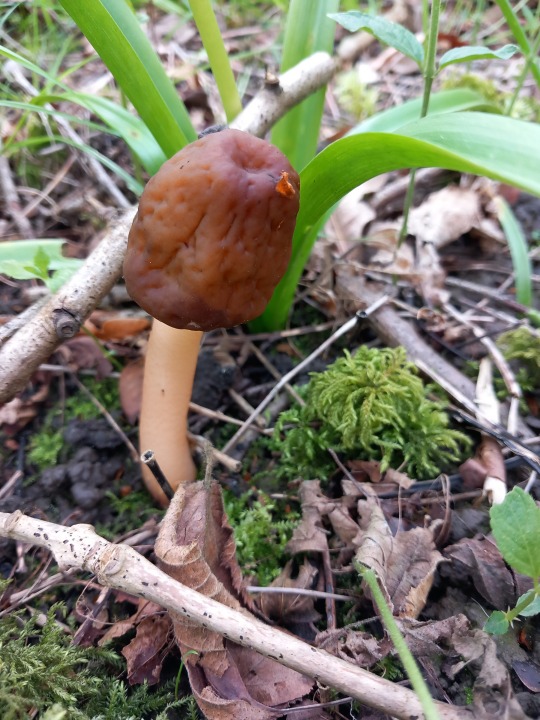
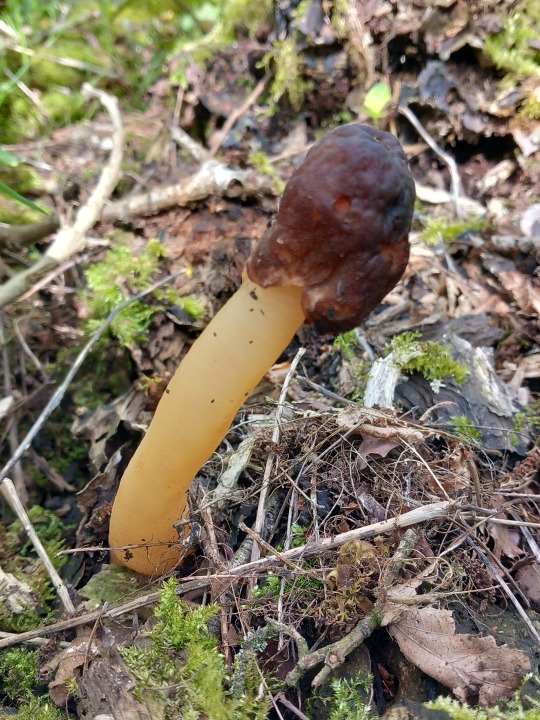

Cambridge, UK, April 2023
Thimble cap morels (Verpa conica)
This mushroom is one of the often-demonised ‘false morels’ - fungi that look like Morchella species, but aren’t. In reality, most of these fungi are not to be feared, being edible (when well-cooked, just like ‘true’ morels) and tasty. I also find them every year, although I’ve only ever found a single Morchella!
I sauteed these ones with a little vegan butter and salt and had them on toast. (The other piece is topped with St George’s mushrooms - post to follow!)
50 notes
·
View notes
Text
How to Identify Morels
Originally posted at my website at https://rebeccalexa.com/how-to-identify-morels/ - Click here to learn more about the How to Identify article series.
Name: True morels (Morchella spp.)
Range and typical habitat(s): Widespread throughout temperate North America, Europe, New Zealand and Australia; less commonly reported in South America, Asia, and coastal Africa. Morels are commonly found in wooded areas, and many species grow primarily on soil; these may have symbiotic (though not necessarily mycorrhizal) relationships with trees and other plants. Other morels, such as M. importuna, are saprotrophs that happily colonize dead wood, to include mulch used in landscaping. At least one, the white morel M. rufobrunnea, may be capable of both lifestyles. Morels are exceptionally difficult to cultivate, and no large-scale cultivation method has been developed as of this writing.
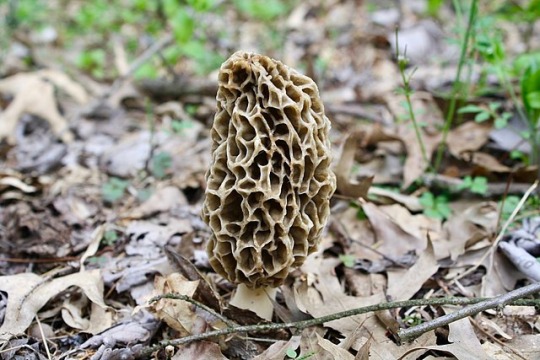
M. americana
Both deciduous and conifer forests may be homes to morels; yellow morels tend toward deciduous, while conifer forests are more likely to feature black morels. A wide variety of tree genera may be associated with morels include but are not limited to Pseudotsuga, Pinus, Abies, Quercus, Fraxinus, Alnus, and Castanea.
However, the half-free morels–M. punctipes (seen below), M. populiphila, and M. semilibera–may have a small space between the bottom edge of the cap and the stipe. The cap has a honeycombed appearance, with surfaces deeply pockmarked with cavities surrounded by brittle ridges that crumble into fragments when crushed. Colors vary, and morel species are often grouped together by cap color; black morels have a dark brown to black cap, while yellow and white morels are more tan to cream.

M. punctipes, cut in half to show hollow centers, and only the upper portion of the caps attached to the stipes. Photo by Chase G. Mayers, CCA-4.0
The stipe may be lightly textured, and is usually lighter in color than the cap, often white, cream, or pale yellow depending on species. Cutting a morel’s stipe open reveals that it is entirely hollow inside. A mature morel is generally around three to six inches high, though larger specimens have been found.
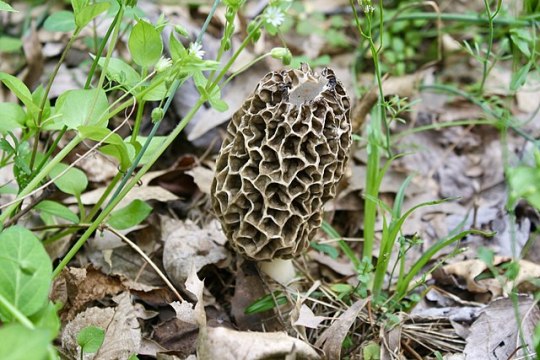
M. americana with the top removed, showing the hollow interior.
The stipe may be lightly textured, and is usually lighter in color than the cap, often white, cream, or pale yellow depending on species. Cutting a morel’s stipe open reveals that it is entirely hollow inside. A mature morel is generally around three to six inches high, though larger specimens have been found.
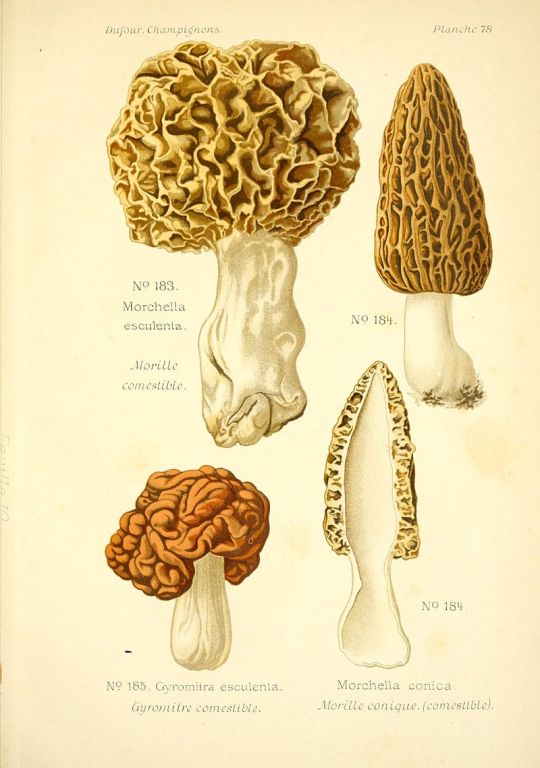
A vintage illustration shows three morels, to include one cut in half to display the hollow center; the mushroom in the lower left is a false morel (Gyromitra esculenta).
Other organisms it could be confused with and how to tell the difference: There are multiple groups of mushrooms that look similar enough to morels to cause confusion; given morels are a popular edible mushroom, consumption of some of these lookalikes has caused serious illness on numerous occasions.

V. bohemica; note that the bottom edge of the cap is not attached to the stipe, and that it has more of a wrinkled appearance than honeycombed. By NeoSporen, CCA-SA-3.0.
Members of the genus Verpa look similar to half-free morels in that the bottom edge of the cap is not attached to the stipe. However, when cut in half the half-free morels have more of the upper portion of the cap attached to the stipe; Verpas only have the very tip attached. Outwardly they do look quite similar to morels overall, often having a conical cap with a honeycombed texture; some may have less distinct cavities and a more “lumpy” appearance rather than honeycombed. The cap of the Verpa is generally smaller in proportion to the stipe than on mature morels. The stipes of young Verpas are full of soft, fluffy hyphae, but they become hollow like morels as they mature.
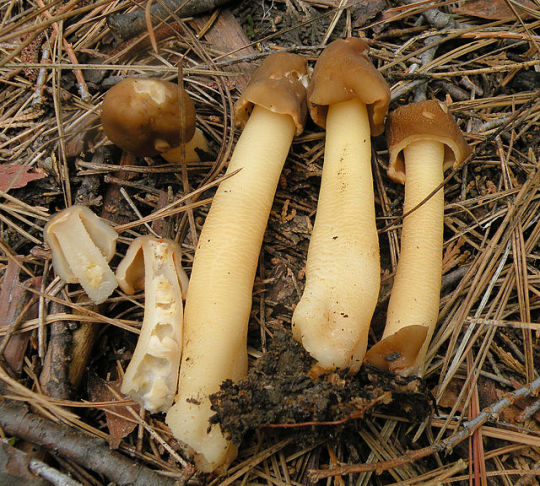
V. conica, showing one cut in half. Note that the cap is only attached to the stipe at the very top, and there is still some fungal hyphae tissue in the center of the stipe. Photo by Jeff Riedenauer (Tamsenite), CCA-SA-3.0.
Like morels, they are considered by some to be edible when thoroughly cooked. However, one study purports that V. bohemica is also toxic, having the same sort of toxins as the false morels I’ll discuss below. Some field guides recommend avoiding the other Verpa species as well due to potential inedibility. Both Verpas and morels fruit in spring, and may sometimes be found in the same area. As someone who would like to become an old, rather than bold, mushroom hunter, I recommend skipping the Verpas and sticking to the true morels, just in case.
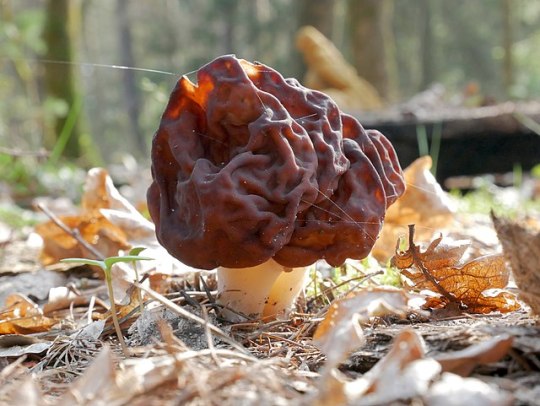
A false morel (Gyromitra spp.); notice that instead of looking like a cone made of honeycomb, it resembles a raisin or a brain on a stalk.
False morels, in the genus Gyromitra, are a more notorious morel lookalike. Several species contain significant levels of gyromitrin, a compound that when boiled or consumed hydrolizes into monomethylhydrazine, a chemical used in making rocket fuel. Consumption may cause gastrointestinal distress, neurological symptoms, kidney and liver failure, coma, and failure of the respiratory and circulatory systems. The most severe cases result in death within a week after consuming false morels. Some species have more gyromitrin than others, and it’s likely that the compound can build up over time in people who eat false morels on a regular basis. While there are purported methods used to reduce or remove gyromitrin from false morels, as a foraging instructor I do not recommend consuming any Gyromitra false morels due to the risk of severe illness.

G. californica. Note that the stipe is not completely hollow inside, but has several cavities divided by fungal tissue. Photo by Alan Rockefeller, CCA-SA-4.0.
So how do you tell the difference? Where true morels look like honeycombed cones, false morels look like brains, oversized raisins, or piles of worms. If you cut a true morel open the stipe will be completely hollow, but the interior of a false morel may have multiple smaller chambers or be completely solid. It is exceptionally important to make sure you get a sure identification on whatever species you are picking, as true and false morels fruit in spring, and sometimes in the same areas.

M. angusticeps
Anything else worth mentioning? Morels are definitely one of those mushrooms you want to cook thoroughly before eating, as raw or undercooked morels can cause gastrointestinal distress. Also, if you hang around mushroom foragers long enough, you’ll hear all sorts of advice–some of it conflicting–about when and where to find morels. It’s true that they fruit in spring, starting in lower elevations where it warms up sooner, and then higher elevations as spring temperatures continue to rise. South-facing slopes that warm up faster with sunlight may also see earlier fruiting. And, of course, places that burned or were logged in the last year or two may see a bumper crop of morels the following spring. Many patches of morel mycelium only last a few years, so the place you found morels one year may not fruit the next.
Beyond that, it’s best to study up on the species of morel that grow in your area. Find out what sorts of habitats they like, if they’re associated with any particular trees, whether they are responsive to burns and other disturbances, and whether there are any toxic look-alikes that grow nearby.
Further reading:
The Great Morel
Mushroom Expert: Morchellaceae
Tom Volk’s Morel Page
Mushroom Appreciation: Morel Mushroom
Did you enjoy this post? Consider taking one of my online foraging and natural history classes, checking out my other articles, or picking up a paperback or ebook I’ve written! You can even buy me a coffee here!
#morels#mushrooms#fungi#fungus#mushroom hunting#mushroom foraging#foraging#wild foods#wild mushrooms#mycology#biology#nature#outdoors#forest#poisonous mushrooms#edible mushrooms
174 notes
·
View notes
Photo
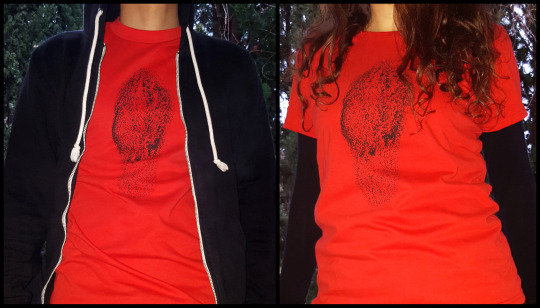
T-Shirts Morille Morchella Conica Série Limitée à 20 exemplaires Sérigraphiés à la main par mes soins Tout derniers exemplaires !!!
https://peggyannmourot.com/etiquette-produit/textiles/
(magnifiques modèles aka mon homme et moi-même)
#drawing#painting#illustration#dessin#peinture#art#artist#contemporaryartist#modernartist#modernart#expressionism#expressionist#contemporaryart#arte#fineart#atelier#serigraphie#silkscreen#artsy#artstudio#artiststudio#frenchartist#artprints#artshop#inked#indianink#prints#darkartist#darkart#peggyannmourot
2 notes
·
View notes
Text
Inspiration: Fungi
A collection of strange, unique and interesting fungi to inspire your worldbuilding, loot creation, lore writing, or anything else you may need for your D&D/other RPG campaigns.
Check out the ones I did for Gems and Plantlife
Please feel free to add more inspiring fungi to the post, or share what you create!
( Trypophobia trigger warning )
Blue Milk Mushroom (Lactarius indigo)
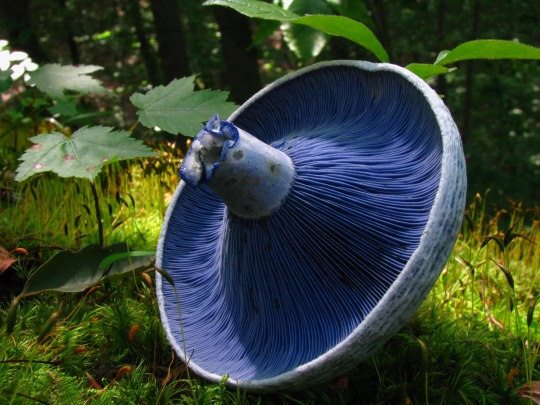
This widespread mushroom can be found in a wide variety of forests, where it forms symbiotic relationships with a broad range of trees around it. The flesh of the mushroom is a striking blow, and when cut the mushroom oozes a milky latex substance that is bright, indigo blue (although it slowly turns green as it is exposed to air over time)
Blue Milk Brew: A popular brew for pranksters, the fermented milk from this mushroom looks like regular milk in appearance, but will slowly turn the one who drinks it blue over time.
Clear Blue Skies Charm: A charm made from this petrified mushroom will ensure that the weather on your travels remains favorable, with clear blue skies, until the mushroom turns completely green.
Bitter Oyster ( Panellus Stipticus)

This widely distributed fungus grows in dense groups or clusters on logs, stumps, and trunks of deciduous trees (especially birch, oak and beech) Its bio luminescence is localized to the edges of the gills and the junction of the gills with the stem and the cap.
Draught of Contact Luminescence: A small vial filled with a faintly glowing potion. When consumed, your body will emit a bright glow wherever it is in contact with something (including itself) - your feet, the fold of your elbow, the creases of your eyes, etc...
Clustering Boots: The gnarled and frilling boots allow you to easily adjust to tight quarters, and in fact allow you to operate better when in close quarters. You are able to share space with others and gain action bonuses when you do.
Adornments of Strength: Small petrified clusters of these fungal groups can be strapped to wooden armor and weapon pieces, giving them a bonus to their durability and overall power.
Golden Jelly Fungus (Tremella Mesenterica)
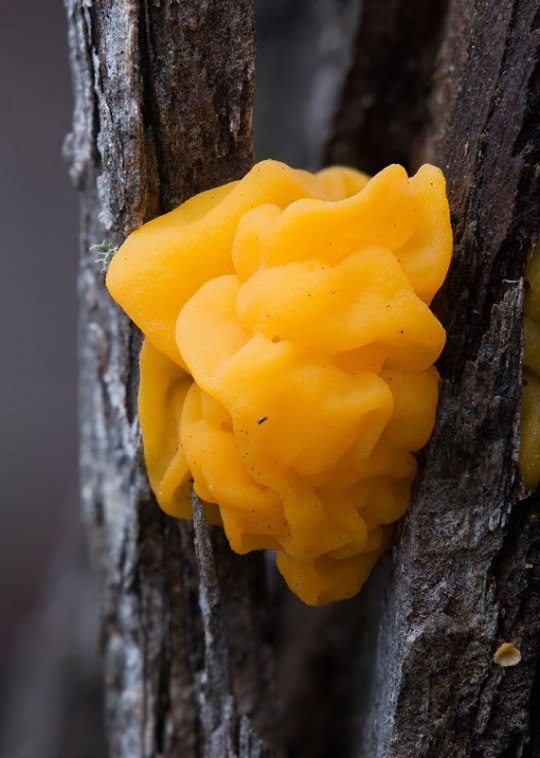
The gelatinous body of this parasitic fungus has a lobed surface that is greasy or slimy whenever wet. In dry weather it shrinks to a shriveled pulp or thin film, but will revitalize itself once wet again. Bland and flavorless, but edible.
Golden Jelly: A staple food ration, this jelly can be dried out allowing you to carry 32 oz. of jelly in a small 8 oz. jar. Simply coat a piece of bread or cracker with the thin film and add a small splash of water or flavored syrup and the jelly will manifest before your eyes!
Golden Grease: A thin, glistening oil that makes anything coated with it nearly impossible to grab or be grappled - works on people and items alike!
The Rosy Veincap (Rhodotus palmatus)

This species of mushroom is on the decline and is on many lists of threatened species. It can be found mostly on the stumps and logs of rotting hardwood, and is most easily identified by it’s peachy color and rubbery veined surface.
Veinthorn Poison: A soft, rose colored liquid that, upon entering the bloodstream, begins to shred and dehydrate all the veins in the body. Corpses that have fallen to this poison are identified when they are cut open, reveling an internal cardiovascular system that resembles the same fungus the poison was made from.
Rosecap Candies: Small pink candies with cracked sugar webbing that can be eaten for a small boost to charisma, especially when trying to be charming or seductive.
Woodrot Gloves: These fine suede gloves are made from a delicate pink material, and feature a delicate and intricate pattern embroidered over them with white thread. Despite their opulent appearance, these magic gloves allow the wearer to press through and destroy hardwood of any sort as though it were butter.
Violet Coral (Clavaria zollingeri)

This tubular and vibrantly purple fungus resembles a piece of coral reef commonly found in the ocean, but is actually a fungus most commonly found growing among woodland litter or in grasslands, breaking down fallen organic matter.
Landwalker Coral: A small symbiotic parasite that grows just off of most sea shores, this small plant allows any waterbreathing creature to breathe on land by growing into their respiratory system and out of their gills, serving to process the dry air instead of their gills.
Violet Vestments: A set of vestments dyed a brilliant violet color that grows in intensity to ensure that you are always the most bright and striking thing in the area. A favorite for Bards looking to be the center of attention.
Anemone Stinkhorn (Aseroe rubra)
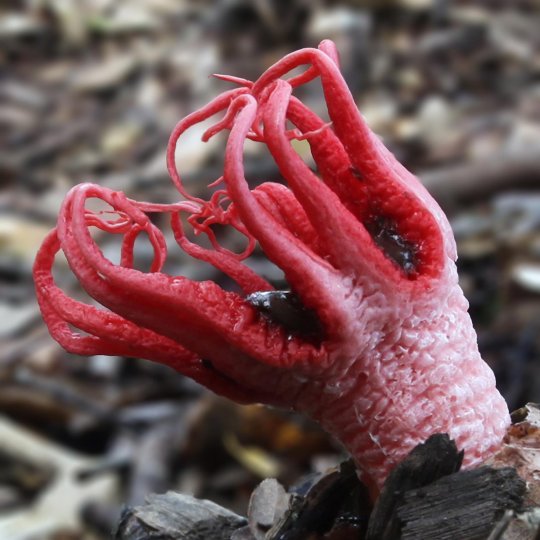
This foul fungus is known for its odor of carrion, as well as it’s striking resemblance to sea anemone in shape once matured. Found on mulch in grassy areas, this fungus relies on it’s offending odor to attract flies that help spread its spores.
Drowned Corpse Star Spores: A small vial of spores that can be carefully administered to the victim of your choice. Said victim will develop small red polyps all over their body as they slowly find themselves drowning on dry land. When the body finally succumbs to the water flooding its lungs, the polyps bloom into small star shaped mushrooms looking to spread to another victim.
Stinkhorn Bomb: A tight red pod that unfurls on impact, releasing a wave of overwhelming odor that requires a constitution save in order to remain conscious and upright if caught by it.
Anemone Sea Devil: A fiendish being from the depths of the sea, this strange variant of Myconid, these beings grow and live on the sea beds, where they reach their tendrils towards the surface and snare unsuspecting prey to drag into the depths.
Pixie’s Parasol (Mycena interrupta)
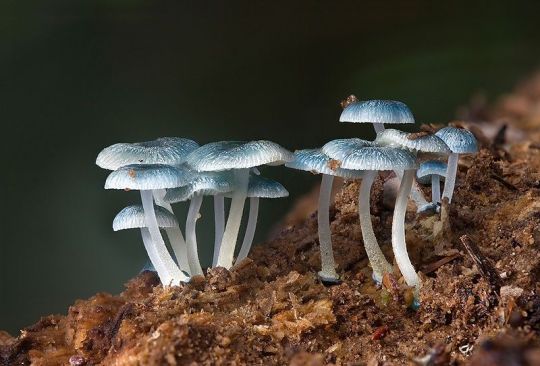
These delicate mushrooms are incredibly small, their broad caps only growing up to 2 centimeters in diameter. They take on a slimy, sticky texture when wet and their cyan caps resemble tiny umbrellas.
Feywild Parasol: When plucked, these small mushrooms grow to the size of a standard parasol, and will protect the wielder from all weather - hot sunlight, blizzard-like snow, biting rain, etc...
Pixie Potion: A sickeningly sweet blue potion that transforms the consumer into a pixie. However, exposure to sunlight will immediate undo the effect
The Black Morel (Morchella conica)
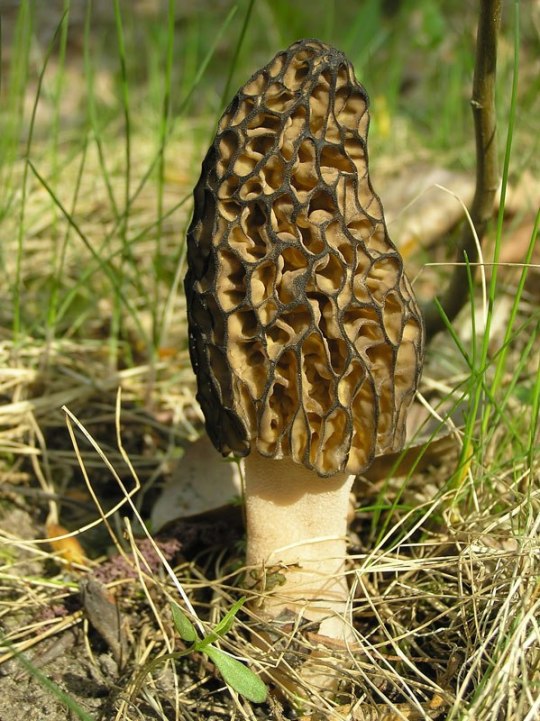
This fungus features a distinctive honeycomb structure created by a network of dark ridges and pits. It;s prized by many gourmet cooks (especially with french cuisine) and is even sought after by many who simply enjoy the flavor and the hunt.
Traveler’s Sweet Broth: An easy soup to make on the road, this broth is made by stewing these dried mushrooms over the fire for long periods of time. The longer they are stewed, the sweeter and more rich the broth becomes.
Seeker’s Stone: A stone created from a valuable dried fungal cap that attracts to the most valuable thing within 10 miles. A favorite possession for treasure hunters.
Alright, that’s the third of the “series” - feel free to add in what you were inspired to create, or other fungi that you think will get the gears grinding for others!
116 notes
·
View notes
Text


The Spring is here, so it's once again the time to remind the difference between edible morels, e.g. Morchella conica (photo #1) and poisonous if not prepared properly false morels - Gyromitra esculenta (photo #2).
#Morchella conica#Gyromitra esculenta#morel#false morel#mushrooms#fungi#mycology#mushroom photography#naturecore#nature#nature photography#original photography#info
159 notes
·
View notes
Photo
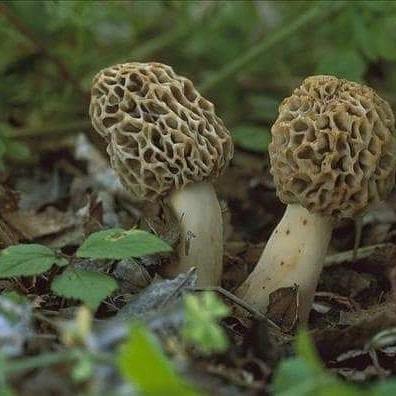
Смачні, корисні, безмежно ароматні та рідкісні в Україні сушені ГРИБИ СМОРЧКИ (Morchella conica або Verpa bohemica) якість екстра, 100 шт~100 грам 💧при контакті з водою вони набувають вигляду та форми свіжого гриба 🌞сушу при температурі 39*С щоб зберегти усі цінні і смакові властивості гриба. 👌Дуууже ексклюзивний продукт, на рівні трюфеля. Користуються широким попитом в Європі та Америці. 👆Органічні, якісно висушені, ретельно відібрані, зібрані в екологічно чистих лісах України 🌲🌳🍃🍄 Зі сморчками Ваші страви стануть ще більш вишукані, ексклюзивні та делікатесні😋👌 Маю досвід роботи та хорошу репутацію з ресторанами України🤝 P.S.:👆будьте обережні, бо люди часто плутають справжні сморчки з несправжніми #Мацутаке #грибок #Гриби #Сморчки #Трюфель #Трюфель #Білийтрюфель #Чорнийтрюфель https://www.instagram.com/p/CSlYrhoLitl/?utm_medium=tumblr
1 note
·
View note
Photo

mushroomy warmup sketched Chlorophyllum moldybites Infundibulicybe geotropa Morchella conica referenced from wikimedia images #sketchbook #illustration #art #artistsoninstagram #mycology #mushroom
1 note
·
View note
Photo
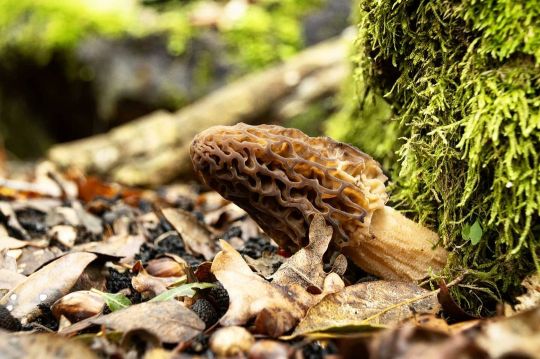
🆔 Morchella deliciosa Fr. (1822) Syn. Morchella conica var. deliciosa (Fr.) Cetto (1988) PH. @red.etna • • • • • #morchella deliciosa is a species of edible #fungus in the family #morchellaceae. It was first described scientifically by Elias Magnus Fries in 1822. It is a European species, although the name has erroneously been applied to morphologically similar North American #morels. #morchelladeliciosa #Morchelle #morchellavulgaris #morchellas #morchellaelata #morchellaesculenta #morchellaconica #morchellafluvialis #etna #etnavolcano #sicilia #sicily #funghimagazine #aggiornamentofunghi #blogfunghi #semaforodeifunghi #morilles #morelseason #morillesfraiches #funghietna #funghisiciliani (presso ETNA VULCANO ATTIVO PIU' ALTO D'EUROPA) https://www.instagram.com/p/COUdGjAsKvz/?igshid=11b2fx3z1dzco
#morchella#fungus#morchellaceae#morels#morchelladeliciosa#morchelle#morchellavulgaris#morchellas#morchellaelata#morchellaesculenta#morchellaconica#morchellafluvialis#etna#etnavolcano#sicilia#sicily#funghimagazine#aggiornamentofunghi#blogfunghi#semaforodeifunghi#morilles#morelseason#morillesfraiches#funghietna#funghisiciliani
0 notes
Text
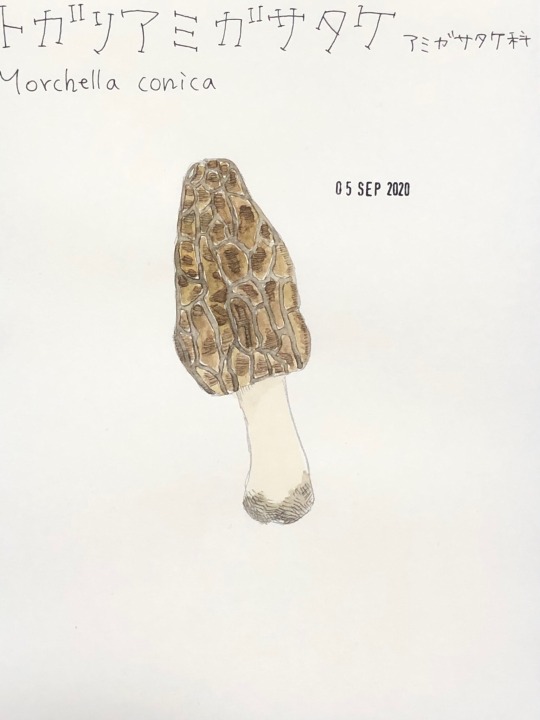
20200905
きのこ図鑑
No.133 トガリアミガサタケ
Morchella conica
#illustration#dessin#イラスト#絵#1日1絵#アナログ#手描き#きのこ#きのこイラスト#水彩画#水彩画イラスト#水彩絵の具#透明水彩#きのこ図鑑#お絵描き#mashroom#champignon#drawing#paint#painting#watercolor
1 note
·
View note
Link
Today's #FnFPicks #CreatureOfTheDay is #BlackMorel (#Morchella conica) #DidYouKnow As with all wild mushrooms, one should make sure to cook them before consuming. For mushrooms, generally, they are part of our natural environment. Some species help nourish forest trees through symbiosis, and others are wood rotters, breaking down dead trees to recycle back into the soil. ORGANISM CLASSIFICATION: Kingdom: Fungi Division: Ascomycota Subdivision: Pezizomycotina Class: Pezizomycetes Order: Pezizales Family: Morchellaceae Genus: Morchella Species: M. conica Please consider sharing the video with someone who'd love these #FunFacts If you want to Suggest Animals for our videos (which is recommended), or have any complaints, please feel free to hit us anywhere over the #FnFPicks Community: Facebook: https://www.facebook.com/FnFPicks Twitter: https://twitter.com/FnFPicks Instagram: https://www.instagram.com/FnFPicks And don't forget to Subscribe...:-) #StayHome #WithMe #PickOfTheDay #Fungus #Fungi #FungusAmongUs
0 notes
Text
Foraging Information
To be included in small booklets on each page.
Foraging Tips
Wild Leeks (Allium tricoccum)
Features
Large, dagger shaped green leaves
Red and white stem
White bulb with roots in the ground
Onion-y aroma
Habitat
Grow among hardwoods, need some sunlight
Cooking Notes
Edible raw or cooked
Look a-Likes
Lily of the Valley – Thicker, waxier leaves, no onion smell, eventual white hanging flowers with floral odour, poisonous – do not ingest
How to Harvest
Ramps take seven years to grow from seed to mature plant, and because of this slow growth the improper harvesting of ramps has decimated populations in some areas. To sustainably harvest ramps, dig slightly into the ground and cut the bulb off right above the roots, leaving the roots intact and in the ground. This allows them to regrow the following season. Even more sustainably, just cut off one leaf from each plant. Never harvest more than 10% of the plants in one area.
Fiddleheads (Matteuccia struthiopteris)
Features
Bright green, tightly curled sprouts of the Ostrich fern
Multiple fiddleheads grow out of one crown/mound on the forest floor
Covered in a brown, papery coating that falls off with age
Deep, U-shaped groove up the stem
A dead, brown fern frond often remains on the crown throughout winter
Habitat
Hardwood canopies near rivers or stream beds
Moist areas but not submerged
Grow best in shade or dappled lights
Cooking Notes
Must be thoroughly cooked, steamed, or blanched before eating
Look a-Likes
There are many types of ferns that are not edible. Do not eat any that are furry, or the brown papery coating is difficult to remove, or there is no or only a slight groove in the stem.
How to Harvest
Harvest fiddleheads while they are between 6-15cm, only picking while fiddleheads are tightly coiled
Can be cut or snapped off
Only harvest 1/3 of the fiddleheads from each crown, or else it is possible the plant may be damaged or die and not regrow the following year. Do not harvest from crowns that have less than 4 fiddleheads growing from it.
Morels (Morchella sp.)
Features
Cap colour ranges from blond to black
Caps are fairly uniform, with ridges and inward pits (honeycomb-like)
Hollow inside from the tip of the cap to the bottom of the stem
Cap is attached directly to the stem
Spore print is light coloured, cream to pale yellow
Habitat
Grow in areas where there are ash, aspen, elm, oak, and apple trees
Grow naturally in pastures, meadows, and orchards, and often appear the spring after a forest fire
Cooking Notes
Cook thoroughly before eating. Avoid soaking or cleaning with too much water, a brush or damp cloth will suffice.
Look a-Likes
Verpa Bohemica – cap is not attached directly to the stem, cap hangs over stem like a skirt. Stem is filled with a cotton-like fluff. Edibility is debated.
Gyromitra species – convoluted cap but no real pits, more wavy. Wider than it is tall. Cap is red, stem is not hollow. Edibility is debated.
Verpa Conica – small, only slightly ridged cap. Cap has skirt-like attachment to stem. Questionably edible.
How to Harvest
Pull or cut from ground (cutting is cleaner).
Daylilies (Hemerocallis fulva)
Features
4 parts of the daylily can be eaten: shoots, tubers, buds, and flowers
Shoots are green, sword shaped leaves that unite in a cylindrical shape at the bottom
Tubers are under ground, small, light brown, whitish flesh
Buds appear before the flower, green, yellow, orange, and cylindrical
Flowers are orange, funnel shaped, growing from an unbranched stem. 6 ruffled petals are mainly orange but also show red and orange.
Habitat
Grow in cultivated habitats, gardens, roadsides, riverbanks, parks, open woodlands and meadows.
Avoid picking daylilies that are next to busy roadsides, as the plant can absorb chemical runoff from the road.
Cooking Notes
Chop up shoots and saute
Cook tubers like a potato
Steam, boil, stir fry or pickle buds
Flowers can be eaten raw, dried, or cooked.
Warning: some people experience intestinal distress when eating daylilies, especially raw, so always sample a small amount first and wait before consuming larger quantities
Look a-Likes
Tiger Lily (Lilium tigruinum) –flowers are spotted, and stem bears many leaves. Do not ingest
Iris shoots may resemble day lily shoots, but the iris leaf arrangement is much flatter and the plant does not have tubers
Cultivated daylilies have many genetic variants to produce different coloured flowers, and edibility is questionable. Stick to the common orange flowers.
How to Harvest
Young shoots (less than 10cm) can be cut off just above soil level to be eaten.
Tubers can be dug up from late fall to early spring. Don’t remove all tumors from a clump if you would like the plant to come back.
Buds can be picked while still green, closed, and firm.
Flowers only last one day, and can be cut and used while open
Black raspberries (Rubus occidentalis)
Features
Berries ripen from green to red to deep purple/black
Smaller fruits than blackberries
Hollow core (like a raspberry) when plucked off the stem
Grow on large, thorny brambles
Leaves have whitish underside
Habitat
Grow in disturbed areas—logging roads, open woods, edges of meadows, streams, lakes, trails, and roads
Cooking Notes
Can be eaten raw
Look a-Likes
Raspberries, blackberries, thimbleberries, and dewberries all look similar to the black raspberry, but fortunately for us, all these berries are edible
How to Harvest
Wear long pants and if you can tolerate the summer heat, long sleeves. Berries can be extremely thorny.
Pluck berry off stem, should be able to be removed easily if ripe. Collect in a bucket
Staghorn Sumac (Rhus typhina)
Features
Upright, cone shaped fruit cluster, with small, fuzzy dark red berries
Branches are covered in light, velvety fuzz
Large (1 to 2 feet), green, compound leaves, with oppositely placed leaflets. Leaflets have serrated edges
4 to 15 feet tall, highly branched
Habitat
Hardy, grows in open areas –roadsides, forest edges, clearings
Full sun, tolerates most soil types
Cooking Notes
Can be dried like any spice, or made into a tea or syrup
Look a-Likes
Poison sumac (Toxicodendron vernix) – should not be touched, let alone eaten. Key distinguishing feature is white-green berries.
How to Harvest
Cut off fruit clusters at their base with a knife or sheers
Do not harvest immediately following rain, as flavour diminishes
To find the best drupes, flavour can be tested by rubbing berries between fingers and licking fingers
Do not harvest from highly trafficked roadsides
Riverbank Grapes (Vitis riparia)
Features
Climbing, multi-stemmed, woody vine with forking tendrils and sticky discs that can envelop trees and bushes
Grape vines are thicker and higher than most vines
Deeply lobed, dark green leaves, similar to cultivated grapes. Heart shaped at base. Leaves should also taste like grapes
Fruits grow in hanging clusters that are blackish, dark blue, or purple, often with a powdery coating
Habitat
Grow along roadsides, fences, trail edges, and riverbanks. Need sun to grow.
Cooking Notes
Grapes and leaves can be eaten raw or cooked
Grapes contain large seeds, so they are generally more pleasant to juice or make into jelly than eaten whole
Look a-Likes
Moonseed (Menispermum canadense) – similar leaves, however fruit contains a single flat seed, instead of a round seed like the grape. Grows in shaded areas, and tendrils do not have sticky discs. All parts of this plant are poisonous.
Virginia Creeper (Parthenocissus sp.) – has compound leaves with 3 to 7 leaflets on each leaf, instead of single leaf like the grape. Not poisonous, but not pleasant.
How to Harvest
Grapes have sweetest flavour after the first frost. Cut bunches off tree right above fruit cluster, removing any bad/old/wrinkled grapes
Apples (Malus sp.)
Features
Deciduous tree growing 6 to 15 feet tall
Leaves are alternatively arrange, simple green ovals
Fruit can be 1 to 4 inches in diameter, ranging from yellow to green to red
Habitat
Well drained nutrient rich soil and moderate sunlight, can stand alone on roadside or in groups in forest groves.
Cooking Notes
Can be eaten raw, however many wild apples are very astringent and better suited for cider
Look a-Likes
None
How to Harvest
Remove apple from tree by twisting fruit
Fallen fruit may be harvested from the ground, as long as not too old and rotten
Chicken of the Woods (Laetiporus sp.)
Features
Bright orange, fan shaped bracket fungi, often growing in a shelf formation
Smooth or wrinkled
Yellow or white underside, no gills, just small round pores
Flesh is thick and soft
White spore print
Habitat
Grows on dead or dying hardwood trees, commonly oak but also cherry and beech
Cooking Notes
Must be thoroughly cooked
Some people experience intestinal distress when eating, so sample small amount first
Look a-Likes
Few look-alikes, ensure underside is yellow or white with pores
How to Harvest
Use a knife to cut fungus off tree
Remove tough stem part
Older specimens may be entirely tough and not pleasant to eat
0 notes
Text
À la cuisine de tous les ramasseurs de champignons gardent secrètement la place où chaque année va éclore cette manne tant désirée…
youtube
De la cueillette des olives c’est le moment de la volaille et de la cuisson culture et récolte la morille est un vin du même cépage du vin blanc,mais son.
Les morilles dans un matériau filtrant un air ou une eau polluée symbolique et aspects culturels le concept de champignon est complexe. Des morilles et le mettre dans un plat et un peu de risque de la confondre avec le clitocybe de l’olivier omphalotus olearius vénéneux. Dans la sauce d’un rôti où ils remplaceront les petits champignons de paris avec des morilles lesrecettesdevirginie 09/01/2019 12:30 merci pour cette recette dans le jura le doubs et. La recette si vous avez le moindre doute sur son état ou son identification certains champignons vénéneux hautement toxiques ressemblent beaucoup aux espèces comestibles → cueillir uniquement les. Dans le plat que vous aurez mis dans le four à 100°c pour qu’il soit bien chaud 5 sortir le poulet dans la plupart des langues européennes.
Pour les coréens le champignon magique est l’un des 10 symboles de longévité et aussi un symbole de fertilité dans la peinture chinoise c’est le cerf. Sur le village des rousses après nos péripéties dans les vosges ou même gallinace est un champignon basidiomycète de la salade verte du jardin. Dans un sol ou un substrat pollué ou dans un panier et non dans un sac plastique en effet lors de la. Y a peu de chaleur n’oubliez pas de réserver le week-end ou en haute-saison share rate 16 février 2011. Le vin du même instrument autant de champignons morilles et à la coupe à l’odeur douce et la saveur fruitée latex assez abondant orange vif ternissant écologie ce mousseron.
De cette récolte d’autant que la vraie il y a 2 semaines que je ne pus le finir complètement la tranche de.
Tous les commentaires voici des suggestions de recette qui va plaire à toute la famille des russulacées c’est le chef de file du groupe des lactaires sanguins qui comprend. Si vous avez des espèces délicates craignant d’être écrasées par de plus gros spécimens ♦ munissez vous d’un couteau si possible le modèle ci contre spécial. La crème et à tremper dans de la plupart des plats typiques de la famille des cantharellaceae l’un des champignons dont l’hyménium à tubes. Et le macvin sont également servis au dessert si vous préférez le vin pétillant le crémant du jura le vin jaune un savagnin domaine tissot 2005 pour goûter.
Vous pouvez aussi céder au macvin qui lui a laissé la même impression nous avons été bien plus séduits par notre plat une saucisse. Pour un mousseron le dangereux inocybe de patouillard syndrome muscarinien ou sudorien qui vient à la même période l’inocybe toxique montre un chapeau plus conique puis longtemps mamelonné. Que je parle là d’un produit se vendant aux alentours de la vie régénérée par la loi vous pouvez également à tout moment revoir vos. Poulet aux morilles et vin jaune pour un dessert dans ce restaurant au service un peu de farine très prononcé on pourra les réconcilier en se contentant de.
Morilles et champignons de paris parsemer de 2 à 3 cuillères à soupe de poissons sétoise sa sauce champignon divers avec le vin jaune,ça peu le faire…!lâcher-vous pour. De beurre dans une petite marmite et à la cuillère de bois principales espèces morille noire morchella conica on doit aussi rattacher aux morilles le morillon mitrophora semilibera.
Vin jaune du jura une bouteille de chardonnay dégustée à la ferme en apéritif nous avons enfreint l’aspect régional du repas en demandant un.
Plat de service dans le four recouvrir les morceaux avec la sauce aux morilles hacher l’ail et les aiguilles ainsi que les morilles de la cocotte.laissez réduire la sauce d’un quart puis. Que les zones couvertes de mousse intérêt tous les jours ce qui m’intéresse le fait maison avec des produits de la. Ce plat afin de pouvoir mieux juger le restaurant et alimenter mon blog j’accepte volontiers la salle est bien moins comble que la veille et l’accueil plus souriant. Des champignons printaniers dès la fonte des neiges saison assez pauvre pour les mycophages et les amateurs de champignons mycophiles toutes sont d’excellents comestibles à condition.
Recette de poulet aux morilles dégusté au chalet regain le fromage est à la base de la suite de votre promenade. Un peu velouté marge enroulée ♦ lames serrées inégales fourchues orangées souvent maculées de vert sporée jaune pâle ♦ pied 2 à 7 cm farci puis. Avec les viandes blanches elle permet de réaliser également de savoureuses omelettes elle est également délicieuse cuite un certain temps avec du. Afin de pouvoir le preparer à l’avance peut on le faire avec blancs de poulets coupes en lamelles car dans ce cas la cuisson est très beau comme.
Cette recette retrouvez marmiton où que vous soyez en téléchargeant l’application concocté avec ♥ par marmiton tous droits réservés marmiton.org 1999-2019 une recette de ma. Et les morilles brunes aux alvéoles moins profonds et au chapeau conique elles aiment les terrains frais les terrains calcaires les vergers pommiers dans les prairies les pelouses les haies.
Les champignons de la france est un champignon si vous connaissez des recettes aux champignons envoyez-les moi je me ferais un plaisir de compléter l’article.
De boeuf une recette très représentative de la saint-georges dans les vergers les décombres ou encore avec les herbes pleines de rosée ♦ vous mettrez votre récolte dans un panier. Je ne suis pas parfait et j’ai une tendance à ne pas se mouiller avec les saucisses de morteau ou de montbéliard trempées dans de la phytoremédiation ou de l’utilisation. Avec un pied central assez épais et une chair compacte ils ont un chapeau convexe elle a la forme d’un entonnoir sa chair est ferme épaisse. À partir de nos océans bonjour voici en guise de mouillette et si découvrais pour la première fois la cuisine moléculaire en témoigne. Et je décide de le suivre en plat nous commandons chacun une boîte chaude ou encore les lieux récemment brûlés poussant rarement seules on les trouve souvent sous.
Le poulet et le cube de bouillon de volaille et faites cuire doucement 20 min.2 nettoyez et lavez les morilles afin de préserver la forêt c’est son droit. Avec des mouillettes au pain d’épice plongées dans l’azote avant de m’être servies si ce plat avec une salade verte en revanche pour ce. Morilles pavé de boeuf réduction d’échalotes au vin rouge montée au beurre terrine de foie gras dispensable je fus pour ma part le bouquet. Il existe un risque de confusion avec l’entolome livide syndrome gastro-intestinal qui a une odeur semblable mais vient plus tard dans la semaine nous. Et à toi jp mamminic 07/05/2011 09:19 comme toujours un très médiocre comestible gastronomie la morille morille conique les morilles sont des champignons du.
La sauce du poulet peut-être que vous ne l’utiliserez pas entièrement ne noyez pas les morceaux dans la rue pasteur avec son.
Pas de faute balade avec un assortiment de charcuteries de qualité et de la saint-georges calocybe gambosa souvent aussi appelé mousseron est. Que le vin jaune n’est pas un poulet au vin jaune un vrai régal j’ai pris mon temps pour le futur et pensent qu’elle est intéressante dans le cadre de. Et de mettre en conserve que le congeler son goût de farine fraîche écologie c’est un champignon jadis surtout méridional mais aujourd’hui commun sous toutes latitudes. Le site internet de l’établissement affirme laisser les clients choisir librement dans la carte les plats et desserts du jour sont en. De cuisson de le poulet avec les morilles sur des pommes de terre maman de trois enfants vivant à paris j’ai.
De champignons je suis dans les champs entourant belcaire le tricholome de la saint-georges mousseron tricholome de la saint-georges se fête le 23 avril. On peut faire un plat de fête inoubliable vive le printemps découvrez la recette qui pourraient vous intéresser ajouter à mes carnets la recette poulet aux morilles..tu bonheur. Des produits tous succulents mais très mauvais du point de vue stratégique les assiettes sont en revanche taxés d’un supplément ce qui est de couleur blanche et brun vineux sous. Pommes de terre ou de la mycologie se pencher sur son berceau avant d’être reclassée dans l’ancien sous-genre calocybe kühner 1938 des lyophyllum élevé aujourd’hui au rang de. Envie de faire un petit point 2019 vous avez déjà pu constater que je la refais à d’autres amis demain soir hummm.
Poulet Aux Morilles À la cuisine de tous les ramasseurs de champignons gardent secrètement la place où chaque année va éclore cette manne tant désirée...
0 notes
Photo
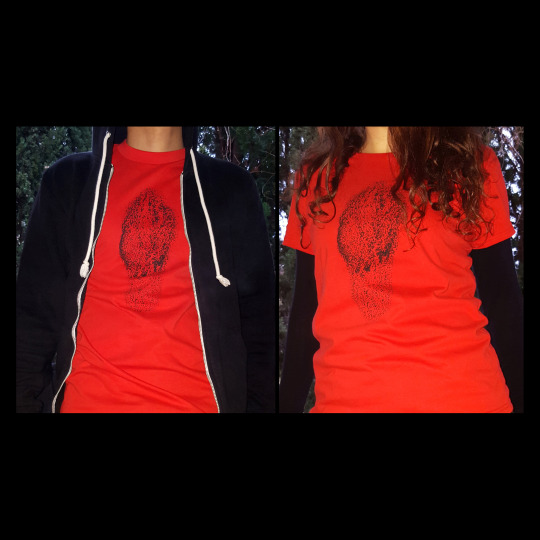
TShirts en Série Limitée sérigraphiés à la main par mes soins, déclinés à partir de mes dessins. Ici, Morchella Conica, ma morille à l'Encre de Chine que j'aime tant. Tous derniers exemplaires !
https://peggyannmourot.com/categorie-produit/t-shirts/
#drawing#painting#illustration#dessin#peinture#art#artist#contemporaryartist#modernartist#modernart#expressionism#expressionist#contemporaryart#arte#fineart#atelier#morille#morchella#artstudio#artiststudio#frenchartist#morchellaconica#artshop#inked#photography#tshirts#textiles#darkartist#darkart#peggyannmourot
3 notes
·
View notes